If you’re looking for an indoor exercising machine that offers a full-body workout with minimal impact on the joints, a rowing machine has all that covered. However, in case you’ve decided that a rower is the machine that would fit perfectly to your needs, you deserve to know as much as  possible about the advantages of these machines, the workout possibilities they offer, what types are out there, and basically every aspect about them. That’s because there are various types of rowers, and each one of them has its own specifics. Needless to say, a certain rower may fit your needs much better than others.
possible about the advantages of these machines, the workout possibilities they offer, what types are out there, and basically every aspect about them. That’s because there are various types of rowers, and each one of them has its own specifics. Needless to say, a certain rower may fit your needs much better than others.
This post aims to provide all the information that you should know about rowing machines before actually choosing and buying one. So, to begin with, let’s have a look at what exactly a rower machine can do for you.
Table of Contents
What Can A Rowing Machine Do For You?
Great for cardio and weight loss
Just like treadmills, spin bikes or elliptical machines, rowing machines can supply the user with a superior cardio workout. Needless to say, by working out daily on a rower, you will improve your cardiovascular health, as rowing will put your heart and lungs to the test. With increased lung and heart activity, more blood will be pumped into your muscle tissue, delivering nutrients and oxygen.
Of course, just as any aerobic exercise, rowing daily can help you burn an important amount of the body’s fat reserve. Actually, a rowing workout can burn calories at quite a fast rate, since it engages more muscle groups than other types of workouts. According to Harvard Health Publications, a vigorous workout on a rowing machine can help a 185 lbs individual to lose 377 calories, during a session of 30 minutes.
Great for endurance and strength training
Simply put, any repeated action that engages a specific muscle group will eventually lead to an increase in strength for that particular muscle group. The rowing motion engages the leg muscles, specifically the thighs, the core and an important amount of back muscles, and of course the arms, with a consistent focus on the forearms and deltoid muscles. Exercising regularly on a rowing machine doesn’t necessarily help you build muscle mass. In general, if you look at the physical build of a professional rower, you will see that they have a harmoniously proportionate body, with lean cut muscles. So, rowing helps a lot with strength building, muscle definition, and an overall healthy muscular shape.
Evidently, just like running or cycling, rowing on a daily basis will help you build stamina. In fact, most professional rowers are required to use indoor rowing machines to maintain their overall stamina and muscle tone, for the off-season periods.
Low impact
Since you’re in a seated position as you row, your legs don’t have to support your whole weight. Therefore, rowing will put less of an impact on your leg joints. However, the rowing motion does put your legs to work, and there will be a little bit of impact, but far lower than for running on a treadmill, for example. As you’re seated in the rowing position, pretty close to the floor, the risk of falling (which may happen quite often when on a treadmill) and sustaining an injury is basically zero. Also, since the complete set of motions in a rowing stroke isn’t too difficult to master, and doesn’t pose an excessive stress with each stroke, chances of any other injury is minimal.
Stress reduction
Many people who take rowing as their main cardio workout, find it soothing for their nerves. After a stressful day of work, an hour of rowing can be quite psychically relaxing, reminding of the rowing of an actual boat. Therefore, after your daily rowing session, you can actually be completely refreshed, mentally and physically.
Possibility of rowing indoors, in lack of a boat
Rowing from the comfort of your home has its own benefits. For example, you can watch TV during your rowing workout, the risk of falling into the water is zero, you won’t have to worry about sunburns, and of course, you won’t have to support any other costs related to rowing an actual boat, such as driving to a lake, renting a rowing shell etc.
Possibility to monitor your performance
There are, of course, performance monitors that can help you track your time spent working out, give you an estimate calorie burn, or help you monitor your heart rate as you row an actual boat, or as you exercise in any other way. However, most indoor rowers come with a specially designed performance tracking computer, which can monitor and register your progress, and indicate important values during your workout, such as speed, strokes per minute, watts, distance traveled, along with the ones mentioned above, time, calories and pulse. The most advanced performance monitors for indoor rowing machines also have online connectivity and give you the possibility to upload your workout data online, analyze it from different angles in order to continuously improve, and also to compete with other rowers.
Types of Rowers
The type of resistance in a rowing machine is the main criteria by which these exercising machines are classified. Depending on their resistance generating mechanism, there are four types of rowers: air, water, hydraulic and magnetic.
Air rowing machines. Also known as wind rowers, this type of rowers are equipped with a

resistance system involving a flywheel shaped somewhat like a fan. As you pull the rower’s chord, strap or chain, the fan will spin, and the air current created will generate resistance. The main advantage of air rowers is that the resistance created is directly proportional to the stroke intensity. This results in a “natural” feel to each stroke, similar to rowing an actual boat. Some air rowers, such as the Concept2 Model D, feature a damper which adjusts the amount of air that enters the fan’s case. The more air, the higher the resistance. Air rowers also feature a sliding seat, which adds a lot of effectiveness to the rowing motion and overall workout.
Air rowers come with a downside though. As the flywheel is set in motion, it will produce a “woosh” sound, which may become annoying after a while.
Water rowing machines. This type of rowing machines involves a water tank, equipped with a paddle which spins into the water, giving tension to each pull. Most experts and professional rowers are inclined to say that this type of rowing machine is the most effective in producing the natural feel of rowing. All water rowers come with a gliding seat. Also, just as for air rowers, the tension of each stroke is increased by the amount of strength the user puts into pulling the strap or chain.
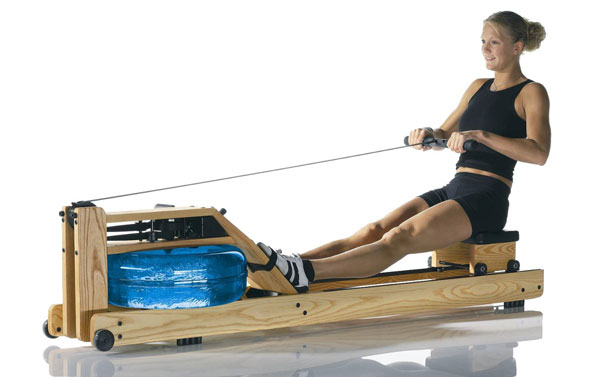
Water rowers are typically heavy, and most of them feature a wooden frame. The sound produced by a water rowing machine is somewhat soothing, similar to an outdoors rowing experience, and considerably less loud than for air rowers. The only downside of these machines is that they’re quite a bit pricey.
Hydraulic rowing machines. As terminology suggests, these rowers use hydraulic pistons as main tension generators. In general, hydraulic rowers feature two “oars” or arms, on

each side of the frame, connected to the piston(s) system. The rowing motion resembles the rowing of a real boat since it involves two oars. Hydraulic rowing machines are pretty quiet, and in general, they feature a smaller footprint than water and air rowers. They’re also the cheapest rowing machines available.
There are two major downsides to be mentioned, regarding hydraulic rowers. First of all, resistance doesn’t change the harder you pull. However, most machines of this kind have adjustable resistance, so you can workout on a tension level of your choice. Also, not all hydraulic rowers have a sliding seat. So, needless to say, the ones with a fixed seat won’t provide a good workout for the legs.
Magnetic rowing machines. These rowers actually use an eddy-current brake system, similar to the ones used in upright or recumbent bikes. The brake (or drive) mechanism
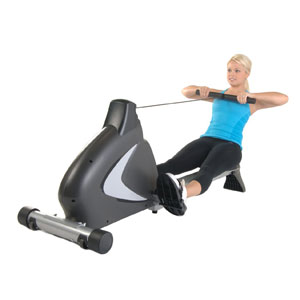
involves a pulley, a flywheel, a servomotor and a magnetic pad. The resistance is increased, by increasing the magnet’s pull, via an electric current. Evidently, these machines require being connected to a power circuit in order for the resistance levels to become available.
Similar to hydraulic rowers, the magnetic ones also feature constant resistance, regardless of the strength the user pulls. They’re also considerably more affordable than air or water rowers. They’re very quiet, and typically have a smaller footprint than water or air rowers.
Now, there are rowing machines that combine some of these types of braking mechanisms. For example, the Sole SR500 is an air rower that uses an eddy current brake to bolster resistance, rather than an air damper, such as most air rowing machines.
Features to Look For
Along with the particular aspects mentioned above, related to the resistance mechanism of each type of rowers, there are quite several other features to study before deciding on a rower for home use. So, here’s a bit of information regarding these aspects.
Frame: foldable vs. non-foldable
Especially air or water rowing machines feature a pretty long frame, and storage or use space for

such a fitness machine can be a problem. However, many rowers feature a foldable frame.
Typically, the gliding seat rail folds up, offering several feet of space length-wise, for storage. There shouldn’t be any stability or durability issues between rowers with and without a folding frame. It’s just important that you opt for the right one, depending on the storage or exercise space you have in your home.
Conversely, if you’re short on space, but do want a rowing machine to exercise with from the comfort of your home, a hydraulic rower may be the most fitting choice. Many of them are half the size of an air rower.
Seat: cushioned vs. padded
If you’ve been looking at rowing machines, you probably have noticed that most of them have a rather hard seat, in most cases padded with a sheet of rubber. These seats are usually contoured,
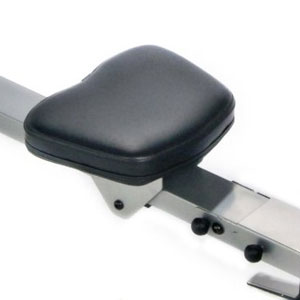
and despite the fact they might be a bit hard, they do ensure all the comfort that a rowing machine should provide. On top of that, a contoured seat can help with the rowing motion, as inexperienced users may find it difficult to maintain the correct position, and have to readjust frequently.
On the other hand, there are rowers which fashion a cushioned seat. This type of seat may seem more comfortable, and especially to users with lower back problems, it might ensure a better comfort, up to some extent.
But the truth is, in terms of comfort there isn’t much difference between a padded seat or a cushioned seat. Lower back problems and numbness can still occur due to the required rowing position and motion. These are actually the main downsides of rowing. But nonetheless, if you opt for a padded, contoured seat, you can always apply a gel cushion on it, if you think it’s too uncomfortable. There are plenty to choose from.
Seat: gliding vs fixed
Most rowing machines have a gliding seat. Needless to say, this type of seat emulates the rowing motion of an actual racing shell. A gliding seat is great to have, as it will provide a superior leg and thigh workout. However, there are rowing machines which feature a fixed seat. Typically hydraulic machines have a seat of this type. These are usually cheaper, and evidently, by working out on one, even if you will benefit from a decent cardio workout, your legs will be pretty much left out.
Seat rail: horizontal vs inclined
Normally, a racing shell requires a horizontal rowing motion. Its seat glides on a horizontal rail. That’s how many indoor rowing machines are designed. There are though, rower models which feature a seat rail slightly inclined. Now, a machine of this type evidently doesn’t supply a completely natural rowing motion. That’s why it’s might not be the best choice for a professional rower, as it might lead the user to develop unwanted habits in their rowing. On the other hand, a slightly inclined rail will offer a better leg and thigh workout, as pushing your whole body slightly upwards, is at least a little harder than pushing it back, with a completely horizontal motion.
Pulling strap vs chain
Most rowing machines come with a strap that connects the pulling handle to the machine’s mechanism. But there are models however which are equipped with a chain, similar to a bike’s chain, for this purpose. Especially air rowers and some of the water-based rower models have a chain instead of a strap. Now, I’m pretty sure many people would like to know what’s best: chain or strap? Well, both come with their pluses and drawbacks.
A pulling chain is highly durable and can last a lifetime without breaking. But it requires greasing. Also, even if the chain is durable, the sprocket over which the chain moves in and out may wear out, causing the chain to skip. Along with that, erratic rowing motion can cause the chain to jump off the sprocket, which requires its adjustment. Of course, if used accordingly, none of these problems should occur. Maintenance is nonetheless required though.
On the other hand, for rowers equipped with a pulling strap, the strap doesn’t require maintenance. Also, each strap is typically made of a very strong nylon, designed to last for years of regular use. The strap can, however, wear out, especially if multiple persons use the machine, and will require replacement. That’s why, when buying a rowing machine with a strap, is a good idea to order an extra one, if available, to have just in case.
Footplates: pivoting vs fixed
When it comes to footrests (or footplates) the best choice are the adjustable ones. These give you the possibility to adjust their angle, in order to find the position that suits you best. However,

there are rower models which have pivoting footrests, which cannot be locked in place, allowing your feet to find their best position during every phase of the rowing motion. This is not a bad idea, as it takes some of the impact on your ankles, which may be great for an elderly user, or for a user recovering from an injury. However, some users may find pivoting footplates somewhat “uncertain”, as they would prefer solid support from their footrests.
On the other hand, certain rowing machines feature completely fixed footrests. In this case, even though the angle of the footrests was correctly selected after laborious research, some users may be unsatisfied or uncomfortable with it. However, improvising and placing something on each footplate to adjust the angle is always possible.
Performance monitor
Most indoor rowing machines feature a fitness meter, or ergometer. The most basic units of this type provide information regarding time, distance, speed, and calories burned. Slightly more advanced consoles, also cover values such apertrokes pe minute, pulse, and wattage. They also include preset workout programs, combining various values.
Now, these are actually the values and features that any rower, professional or not, should expect from a rower’s console. However, there are rowing machines equipped with consoles which incorporate various games, and/or feature online connectivity. Being able to export your progress online, to analyze it from a different perspective, or compare it with the date of other rowers, and even compete. These features help a lot in keeping you motivated and make the workout more enjoyable. But evidently, they bring the overall price of the machine up. So, it’s up to you to decide should you opt for them or not.
Other Aspects to Consider Before Buying
The training that you require. It pretty much goes without saying, that indoor rowers are machines made for aerobic training and muscle toning. Of course, they’re also great machines for losing weight. To put it differently, they can help you with muscle cutting, but not particularly with building muscle mass. Rowing machines promote an harmonious development of the whole body.
Available space. Especially rowers with a gliding seat are lengthy, sometimes over 80 inches, as they must supply a complete stretch for the user’s legs, even in case of tall users. Therefore, you might want to check and double check if the rower you’re looking at will fit into your home. Also, when it comes to this, foldability may help.
Noise level. The only models that you should worry about when it comes to noise, are air resistance rowers. These produce a fair amount of noise as you stroke. However, the noise problem can always be solved by listening to music or turning the TV a bit up.
Budget. Just about any exercising machine is an investment. Whether you want to buy an indoor cycle, a treadmill or a rower, I’m pretty sure you would like it to last. That’s why it’s best to invest in a top-quality model, even if it’s a bit more expensive. There are many affordable rowing machine models though. If you’re looking for one, start with the hydraulic models, with a gliding seat, such as the Kettler Favorit, for example.
A Few Recommendations
There are many companies who offer rowing machines, among gym equipment of other types. But only a few make the best rowers on the market. Therefore, in the last section of this post, I’m will point out some of the best brands that you should look for if you want a rowing machine for home use, and one of best models for under each brand.
Stamina
Stamina Products Inc., is a developer, manufacturer, and provider of exercising machines of all sorts. It’s actually the first company to provide affordable Pilates reformers for home use. They currently offer several rowing machines, with hydraulic, magnetic and air resistance. One of the rowers from Stamina which benefits from a lot of positive feedback is the Stamina Air 1399.
 The Stamina Air Rower 1399 is actually one of the most affordable rowing machines with air resistance. It’s also a foldable machine, 77″L x 18″ Wx 22″H, with a cushioned, gliding seat, offering a naturally adjusting rowing stroke. Despite its low price, the quality of this product stands pretty high, also the machine being equipped with a performance monitor, to indicate distance, time, calories and speed… Read Full Review.
The Stamina Air Rower 1399 is actually one of the most affordable rowing machines with air resistance. It’s also a foldable machine, 77″L x 18″ Wx 22″H, with a cushioned, gliding seat, offering a naturally adjusting rowing stroke. Despite its low price, the quality of this product stands pretty high, also the machine being equipped with a performance monitor, to indicate distance, time, calories and speed… Read Full Review.
Sunny Health & Fitness
Sunny Health & Fitness offers several rowing machines, with different types of resistance. Most of them are priced under $300-$400, so if you’re looking for a budget rowing trainer, this brand name may be a good choice. Some of the models released in the past two years are the SF-RW5606, SF-RW5622, SF-RW5623, and SF-RW5515. Among them, them most  popular and maybe the model with the best price/quality ratio is the SF-RW5515.
popular and maybe the model with the best price/quality ratio is the SF-RW5515.
The Sunny SF-RW5515 is rowing machine designed for home use. It offers a long travel for the seat, and due to this fact it can accommodate users taller than 6’5″. However, its weight capacity is only 250 lbs. It has a folding design and is equipped with a manual magnetic resistance system with 8 levels, while its ergometer is a basic unit… Read Full Review.
First Degree Fitness
There are currently over 10 rowing machines under the First Degree Fitness brand name, and most of them feature a water resistance system that a multiple level water tank. The adjustable water tank is actually a core feature of all FDF trainers. All First Degree Fitness rowing machines, even the ones that are designed for home use, have a durable, sturdy construction which is pretty close to the commercial grade models. Some of the most 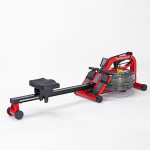 popular ones are the Newport AR, Viking II, and Apollo Pro II.
popular ones are the Newport AR, Viking II, and Apollo Pro II.
Among these, the FDF Newport AR is the one that stands out. Although it’s an older model (it was released in 2014), it still continues to benefit from an impressive feedback from all users, and currently has almost a clean 5-star rating on various websites. The FDF Newport AR is a water resistance rower which offers 4 levels of resistance and comes with an ergometer with a USB port, which shows time, distance, 500M split time, strokes per minute, calories per hour, watts and heart rate… Read Full Review.
Concept2
Concept2 is a company which specializes in rowing machines and indoor ski training machines. They offer some of the best air rowers on the market, all of them made for professional and gym use. They currently offer three air rowers: Model D, Model E and the Dynamic model. The highest rated is Concept2 Model D.
 The Concept2 Model D Rowing Machine is one of the air rowers widely recognized by competitive rowers as a standard for indoor training. It’s a foldable unit, with adjustable footrests. The flywheel features a damper, allowing the user to increase the resistance, actually featuring 10 levels on the damper. It comes with an advanced performance monitor, which can track heart rate, and also supports workout data export via USB flash drives… Read Full Review.
The Concept2 Model D Rowing Machine is one of the air rowers widely recognized by competitive rowers as a standard for indoor training. It’s a foldable unit, with adjustable footrests. The flywheel features a damper, allowing the user to increase the resistance, actually featuring 10 levels on the damper. It comes with an advanced performance monitor, which can track heart rate, and also supports workout data export via USB flash drives… Read Full Review.
WaterRower
There aren’t many companies to offer water resistance rowing machines. But evidently, as the name suggests, WaterRower is one of them. This company offers several models of rowing machines, exclusively water-based, with a sleek design and wooden frame, reminding of an actual boat. WaterRower rowing machines are widely recognized as some of the models that can render the feel of rowing almost naturally. Pretty much the only downside of the rowing machines from WaterRower is their rather high price. However, you do get what you pay for, as 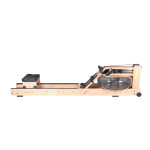 quality is the word that defines the rowing machines from this manufacturer.
quality is the word that defines the rowing machines from this manufacturer.
WaterRower Natural is one of the most widespread models provided by this company. It’s currently available with frames made of various wood types, such as ash, cherry or walnut. It’s a rower designed to accommodate users of all sizes and levels, equipped with a gliding padded seat and a 5-gallon water tank… Read Full Review.
Our Best Recommendations by Price
Now, the price of a fitness machine (not necessarily a rower) can be misleading. Price doesn’t always indicate quality. There are actually many excellent rowing machines under $500 that can supply just about everything that you would expect from one. And on the other hand, you’ll find expensive rowers, which feature a construction and array of features that doesn’t stand up to their price.
Depending on price, rowing machines can be classified by three major categories:
- under $500 – this category usually includes magnetic rowers, hydraulic rowers or even air rowers, but with a basic array of features;
- between $500 and $1,000 – this category includes rowers with all types of resistance; most of them include a rich array of features, and some of them even have the construction required for gym use;
- over $1,000 – rowers with a solid build, high user capacity, made to function 24/7 within the premises of a gym.
Therefore, here are a few quality rowers for each price interval.
Price: Under $500
 Similar to Sunny Health & Fitness, Stamina offers several rowing machines under the mark of $300, such as the Stamina ATS air rower, or the Stamina Orbital 1215. Our recommendation here is the Body Trac Glider 1050 as it’s a model that benefits from an impressive positive feedback. It costs less than $200, which makes it one of the most affordable rowers available at the moment.
Similar to Sunny Health & Fitness, Stamina offers several rowing machines under the mark of $300, such as the Stamina ATS air rower, or the Stamina Orbital 1215. Our recommendation here is the Body Trac Glider 1050 as it’s a model that benefits from an impressive positive feedback. It costs less than $200, which makes it one of the most affordable rowers available at the moment.
The Stamina Glider 1050 is a hydraulic rowing machine offering 12 levels of resistance. Like most trainers of this sort, it has a small footprint which makes it ideal for use in a small room. On top of that, the frame is foldable. The frame combines steel and aluminum elements, its rail being rated for a user capacity of 250 lbs. As opposed to other hydraulic rowers, the seat is not fixed; it glides on the rail, in order to simulate the rowing motion better. The rower is equipped with a basic ergometer which… Read Full Review.
Sunny Health & Fitness SF-RW5515
 If you’re looking for a budget rowing machine, Sunny Health & Fitness should be a brand name to put on your list. They sell quite a few models which cost less than $300. We’ve chosen the Sunny SF-RW5515 for our recommendation here, as it seems to be the most popular. However, models such as the Sunny SF-RW5623, or Sunny SF-RW5639 great machines with an average user rating of 4 stars.
If you’re looking for a budget rowing machine, Sunny Health & Fitness should be a brand name to put on your list. They sell quite a few models which cost less than $300. We’ve chosen the Sunny SF-RW5515 for our recommendation here, as it seems to be the most popular. However, models such as the Sunny SF-RW5623, or Sunny SF-RW5639 great machines with an average user rating of 4 stars.
The Sunny SF-RW5515 is rowing machine designed for home use. It offers a long travel for the seat, and due to this fact it can accommodate users taller than 6’5″. However, its weight capacity is only 250 lbs. It has a folding design and is equipped with a manual magnetic resistance system with 8 levels, while its ergometer is a basic unit… Read Full Review.
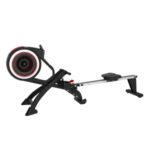 The Marcy Turbine NS-6050RE is a rowing machine released in 2016. However, it’s still available and so far has gathered a fairly decent amount of positive (4.5-stars+) on various fitness websites. It has a resistance system part air, part magnetic. It features a frame construction quite similar to various commercial rowers, such as Concept2 models. It has a durable frame, and even though it’s specified maximum user capacity is 300 lbs (136 kg), various users have confirmed that it can support at least 20-30 lbs more.
The Marcy Turbine NS-6050RE is a rowing machine released in 2016. However, it’s still available and so far has gathered a fairly decent amount of positive (4.5-stars+) on various fitness websites. It has a resistance system part air, part magnetic. It features a frame construction quite similar to various commercial rowers, such as Concept2 models. It has a durable frame, and even though it’s specified maximum user capacity is 300 lbs (136 kg), various users have confirmed that it can support at least 20-30 lbs more.
The Marcy Turbine has a seat that is quite a bit wider than for other models. It’s padded and contoured, offering excellent ergonomics, and reducing a bit of the stress on the lower back. Also, a fitness meter a bit more than basic is provided with the machine. This unit features a 7-panel display, so all the workout metrics can be viewed simultaneously. It tracks time, speed, distance, stroke count… Read Full Review.
Price: $500 – $1,000
First Degree Fitness Newport AR
 The Newport AR is one of the oldest rowing machines from First Degree Fitness. However, since its one of the rowers that offer an exceptional price/value/quality ratio, it’s still available in 2018 and continues to gather 5-star reviews from most users.
The Newport AR is one of the oldest rowing machines from First Degree Fitness. However, since its one of the rowers that offer an exceptional price/value/quality ratio, it’s still available in 2018 and continues to gather 5-star reviews from most users.
Like mode rowers from First Degree Fitness, this particular model not only that has water resistance, which offers a dynamic response during rowing depending on the force behind each stroke, the water level in the tank is adjustable, so you can actually change the levels of resistance. Many other rowers featuring a water resistance system, such as the WaterRower ones, don’t have any resistance settings, so in order to change the overall resistance, you have to add or remove water from the tank.
The FDF Newport AR features a steel frame with an aluminum monorail for the seat. The water tank is made of solid polycarbonate material and has a capacity of 17 liters (4.5 gal)… Read Full Review.
 The LifeCORE Fitness R90 is also an air rowing machine, but as opposed to the Concept2 models, it doesn’t have a damper as adjustment system for its resistance. Instead, it uses a manual magnetic resistance system which offers 6 distinct levels.
The LifeCORE Fitness R90 is also an air rowing machine, but as opposed to the Concept2 models, it doesn’t have a damper as adjustment system for its resistance. Instead, it uses a manual magnetic resistance system which offers 6 distinct levels.
The LifeCORE R90 has a steel/aluminum construction with a weight capacity of 300 lbs. The frame features a folding design, and with the rail folded up, its total length is reduced to approx. 41″. Its monorail is long enough to accommodate users up to 6’7″, allowing a complete leg extension and promoting a correct rowing form.
The machine is equipped with a mid-range fitness meter, featuring a multi-panel LCD display. Its readouts are 500m time, total time, total strokes, strokes per minute, watts, calories, speed, distance, and pulse. The distance and speed readings can only be displayed in metric units. Also, the unit can only read your pulse via a wireless HR chest strap, and this accessory is not included… Read Full Review.
 The Concept2 Model D has been one of the best (if not the best) air rowing machines for the past several years. So far, it has a clean, 5-star rating on most websites, and therefore, it simply must be one of our recommendations. It’s a commercial-grade machine, currently priced for less than $1,000.
The Concept2 Model D has been one of the best (if not the best) air rowing machines for the past several years. So far, it has a clean, 5-star rating on most websites, and therefore, it simply must be one of our recommendations. It’s a commercial-grade machine, currently priced for less than $1,000.
The Concept 2 Model D features a heavy-duty steel frame with an aluminum monorail. It has an impressive weight capacity of 500 lbs. It’s also a pretty long machine, the standard length of the gliding rail being able to accommodate tall users, with an inseam of 38″. Even more, there’s the possibility to opt for a longer rail, in case you’re a really tall person. The resistance system is air-based, but as opposed to other machines, the flywheel casing has a damper which allows you to change the airflow intensity and the overall resistance. The machine comes with the PM5 ergometer, which … Read Full Review.
Price: Over $1,000
 WaterRower not only that offers top-quality rowing machines, but all of them feature a water resistance system, which is known to provide the most natural rowing feel and a dynamic response during each stroke. Also, most of their models feature a very stylish design, with a warm, wooden frame.
WaterRower not only that offers top-quality rowing machines, but all of them feature a water resistance system, which is known to provide the most natural rowing feel and a dynamic response during each stroke. Also, most of their models feature a very stylish design, with a warm, wooden frame.
The WaterRower Natural is one of the oldest models, featuring classic design lines. The wooden frame (ash, cherry or walnut) is coated with Danish oil, which results in a very smooth finish, without being glossy or slippery, considerably increasing its liquid resistance. Since it’s a wood frame, it absorbs shock and vibration much better than a metallic frame, also being lighter.
The water tank is made of durable polycarbonate material. The seat is padded but not cushioned, supplying the optimal comfort that any user should benefit from when using a rowing machine. The included S4 console offers several workout programs, also being PC interface capable… Read Full Review.
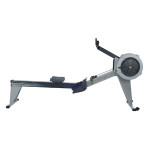 Just as the Model D, the Concept2 Model E is one of the highest rated air rowing machines available at the moment. It costs approx. $200 more than the Model E, though, as it offers several extra features. First of all, it has higher rear and front stabilizers; due to this fact, the seat is placed at approx. 20″ above floor level which makes entry and exit easier, especially for elderly users or users with disabilities. The chain housing is fully closed, offering a bit of extra safety. Plus, the frame has a double coating finish with a glossy aspect.
Just as the Model D, the Concept2 Model E is one of the highest rated air rowing machines available at the moment. It costs approx. $200 more than the Model E, though, as it offers several extra features. First of all, it has higher rear and front stabilizers; due to this fact, the seat is placed at approx. 20″ above floor level which makes entry and exit easier, especially for elderly users or users with disabilities. The chain housing is fully closed, offering a bit of extra safety. Plus, the frame has a double coating finish with a glossy aspect.
The Concept2 Model E comes with the same PM5 fitness meter as the model D. This unit tracks speed, pace, distance, time, calories and wats. There are five display options, such as all data, bar chart, large print, force curve and paceboat. You can set your own targets for values such as time, distance or interval. Plus, there are 5 preset workouts… Read Full Review.
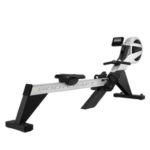 The BodyCraft VR500 Pro is a commercial grade rower featuring a heavy-duty anodized aluminum frame but also integrates steel and hard plastic elements. To be more specific, the gliding beam is made of aluminum, while its support legs are steel-made, and the fan casing is ABS-made. It has a thick and solid monorail rated for a user capacity of 350 lbs. Its seat features a contoured surface and a layer of padding which is not extremely thick but provides the adequate comfort for prolonged rowing sessions.
The BodyCraft VR500 Pro is a commercial grade rower featuring a heavy-duty anodized aluminum frame but also integrates steel and hard plastic elements. To be more specific, the gliding beam is made of aluminum, while its support legs are steel-made, and the fan casing is ABS-made. It has a thick and solid monorail rated for a user capacity of 350 lbs. Its seat features a contoured surface and a layer of padding which is not extremely thick but provides the adequate comfort for prolonged rowing sessions.
The BodyCraft VR500 Pro features an air & magnetic resistance system. The fan element provides a dynamic response during rowing; in other words, the resistance increases if you pull harder. The magnetic brake, on the other hand, allows you to adjust the machine’s overall resistance, offering 32 distinct levels. The ergometer unit included with this machine is quite an advanced one. It offers 12 preset workout programs and 4 user profiles… Read Full Review.
Our Final Pick: Best Rowing Machine For Home Use
As we’ve mentioned above, the Concept2 Model D has been one of the best (if not the best) air rowing machines for several years in a row. It’s still available in 2018, and so far it has a clean 5-star rating sheet on most fitness and retailer websites. Even though it’s a  commercial grade trainer it’s not an overpriced one. It currently costs less than $1,000 and offers an exceptional price/quality/value ratio.
commercial grade trainer it’s not an overpriced one. It currently costs less than $1,000 and offers an exceptional price/quality/value ratio.
The Concept2 Model D features a steel & aluminum construction, with a monorail rated for users up to 500 lbs. Although the frame is fairly large, especially lengthwise, the rail with the seat can fold up, offering better storage possibilities. Its seat is fairly large and contoured, designed to deliver optimal comfort. It’s equipped with heavy-duty wheels which integrate sealed bearings for a smooth and quiet motion.
The machine features an air resistance system. The fan casing is also equipped with a damper which offers 10 adjustment settings. By adjusting the airflow inside the fan casing, you can adjust resistance. When used on the 8-10 settings, the resistance it provides is considerably high, supplying a high-intensity workout.
The machine comes with a performance monitor which not only can track the most important data, such as speed, distance, pace, watts, and calories, it also features several games, which can help you kill the boredom of a long rowing session… Read Full Review.

